
Concept explainers
A hollow sphere of radui R has a uniform nagative surface charge density -\sigma on its surface and a positive point charge +Q at its center. The charge Q is greater than the absolute magnitude of the total charge on the surface. The direction of the E-field is radially outward both inside and outside the sphere.
What is the magnitude of the E-field inside the sphere at a distance r<R from the center?
What is the magnitude of the E-field outside the sphere at a distance r<R from the center?
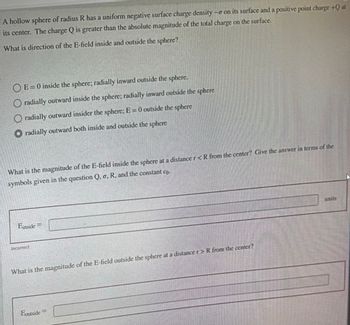
Step by stepSolved in 4 steps with 3 images

Step 3: Electric Field Outside the Sphere answer is incorrect. Can we try again?

Step 3: Electric Field Outside the Sphere answer is incorrect. Can we try again?
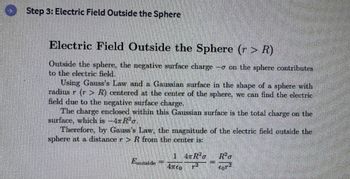
Step 3: Electric Field Outside the Sphere answer is incorrect. Can we try again?
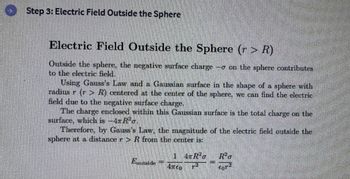
Step 3: Electric Field Outside the Sphere answer is incorrect. Can we try again?
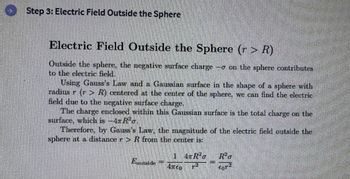
Step 3: Electric Field Outside the Sphere answer is incorrect. Can we try again?
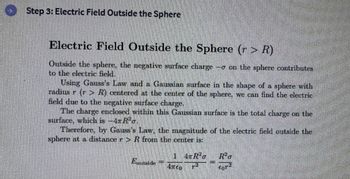
Step 3: Electric Field Outside the Sphere answer is incorrect. Can we try again?
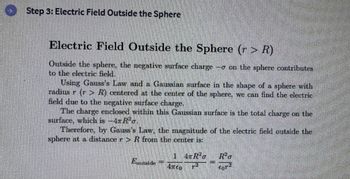
Step 3: Electric Field Outside the Sphere answer is incorrect. Can we try again?
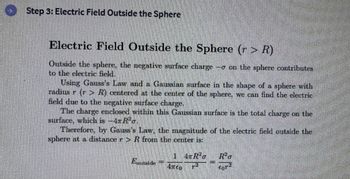
Step 3: Electric Field Outside the Sphere answer is incorrect. Can we try again?
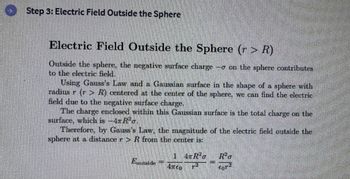
Step 3: Electric Field Outside the Sphere answer is incorrect. Can we try again?

Step 3: Electric Field Outside the Sphere answer is incorrect. Can we try again?
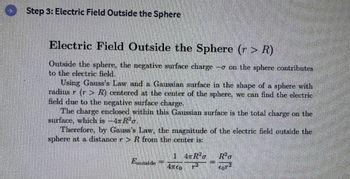
Step 3: Electric Field Outside the Sphere answer is incorrect. Can we try again?

Step 3: Electric Field Outside the Sphere answer is incorrect. Can we try again?

Step 3: Electric Field Outside the Sphere answer is incorrect. Can we try again?

Step 3: Electric Field Outside the Sphere answer is incorrect. Can we try again?

Step 3: Electric Field Outside the Sphere answer is incorrect. Can we try again?

Step 3: Electric Field Outside the Sphere answer is incorrect. Can we try again?

Step 3: Electric Field Outside the Sphere answer is incorrect. Can we try again?

Step 3: Electric Field Outside the Sphere answer is incorrect. Can we try again?

Step 3: Electric Field Outside the Sphere answer is incorrect. Can we try again?

Step 3: Electric Field Outside the Sphere answer is incorrect. Can we try again?

- Please please type the answer instead of writing, thanksarrow_forwardAn infinite sheet charge of has a charge density of +25.9 pC/m-and covers the entire x-y plane. A second infinite sheet of charge ha a charge density of -58.6 pC/m2 covers the entire y-z plane. What is the magnitude of the electric field at any point not on either surface?arrow_forwardA hollow conducting sphere has an inside radius of r1 = 0.17 m and an exterior radius of r2 = 0.27 m. The sphere has a net charge of Q = 5.4E-06 C. What is the field E1 in N/C 1 m from the sphere's exterior surface? What is the magnitude of the field at a distance of 0.05 m from the center of the sphere?arrow_forward
- The entire y axis is covered with a uniform linear charge density 2.2 nC/m. Determine the magnitude of the electric field on the x axis at x= 5.5 m.arrow_forwardThe figure shows a solid non-conducting sphere of radius a = 4.4 cm. It is surrounded by a charged conducting spherical shell of inner radius b = 15.3 cm and outer radius c = 24.8 cm. The inner sphere has a net charge of q1 = 9 nC and the conducting spherical shell has a net charge of q2 = -7 nC. a. What is the surface charge density on the inside surface of the spherical shell? b. What is the surface charge density on the outside surface of the spherical shell? c. What is the value of the electric field at a distance r = 58 cm from the centre of the spheres? Please use a negative value to indicate the electric field points toward the centre of the spheres and a positive value to indicate away from the centre of the spheres.arrow_forwardA charge of uniform linear density 2.00 nC/m is distributed along a long, thin, nonconducting rod. The rod is coaxial with a long conducting cylindrical shell (inner radius = 4.20 cm, outer radius = 9.80 cm). The net charge on the shell is zero. (a) What is the magnitude of the electric field at distance r = 14.0 cm from the axis of the shell? What is the surface charge density on the (b) inner and (c) outer surface of the shell?arrow_forward
- A total amount of positive charge Q is spread onto a thin non-conducting circular annulus of inner radius a and outer radius b. The charge is distributed in a way so that the charge density per unit area is given by ? =??3, where r is the distance from the center of the annulus to any point on it and k is a constant.(a) Find an expression for the total charge Q on the annulus. (b) Find an expression for the potential V at the center of the annulus in term of Q, a and barrow_forwardA thin, copper washer of inner radius R = 54.0 mm and width d = 27.0 mm carries a unformly distributed total charge Q-9.00 nC. Determine the z-component of the electric field, Ez, due to the washer at a distance z = 12.0 cm along the washer's symmetry axis. Ez = -7.99 ×104 Incorrect N/C y Zarrow_forwardA cube has positive charge +Q in all corners except for one, which has a negative point charge - Q. Let the distance from any corner to the center of the cube be r. What is the magnitude and direction of the of electric field at the center of the cube (point P)?arrow_forward
- There are two uncharged concentric conducting spherical shells and a separate point charge. The smaller shell has an inner radius of 0.100m and an outer radius of 0.200m. The larger shell has an inner radius of 0.300m and and outer radius of 0.400m. A point charge of +10.0μC is placed between the two shells at a radius of 0.250m from the origin. Determine the net charge on each of the four surfaces (r = 0.1,0.2, 0.3, 0.4) and make a sketch that indicates BOTH the electric field lines and the surface charge densities. (this sketch does not have to be exactly mathematically correct, but use intuition)arrow_forwardThe figure shows a hollow metal sphere with inner radius 6.70 cm and outer radius 13.5 cm and a point charge at the center. The inner surface of the hollow sphere has a total charge of 3.70 nC and the outer surface has a total charge of -15.5 nC. Calculate the magnitude electric field a distance 18.0 cm from the center of the sphere.arrow_forwardThe question is in the picture.arrow_forward
 College PhysicsPhysicsISBN:9781305952300Author:Raymond A. Serway, Chris VuillePublisher:Cengage Learning
College PhysicsPhysicsISBN:9781305952300Author:Raymond A. Serway, Chris VuillePublisher:Cengage Learning University Physics (14th Edition)PhysicsISBN:9780133969290Author:Hugh D. Young, Roger A. FreedmanPublisher:PEARSON
University Physics (14th Edition)PhysicsISBN:9780133969290Author:Hugh D. Young, Roger A. FreedmanPublisher:PEARSON Introduction To Quantum MechanicsPhysicsISBN:9781107189638Author:Griffiths, David J., Schroeter, Darrell F.Publisher:Cambridge University Press
Introduction To Quantum MechanicsPhysicsISBN:9781107189638Author:Griffiths, David J., Schroeter, Darrell F.Publisher:Cambridge University Press Physics for Scientists and EngineersPhysicsISBN:9781337553278Author:Raymond A. Serway, John W. JewettPublisher:Cengage Learning
Physics for Scientists and EngineersPhysicsISBN:9781337553278Author:Raymond A. Serway, John W. JewettPublisher:Cengage Learning Lecture- Tutorials for Introductory AstronomyPhysicsISBN:9780321820464Author:Edward E. Prather, Tim P. Slater, Jeff P. Adams, Gina BrissendenPublisher:Addison-Wesley
Lecture- Tutorials for Introductory AstronomyPhysicsISBN:9780321820464Author:Edward E. Prather, Tim P. Slater, Jeff P. Adams, Gina BrissendenPublisher:Addison-Wesley College Physics: A Strategic Approach (4th Editio...PhysicsISBN:9780134609034Author:Randall D. Knight (Professor Emeritus), Brian Jones, Stuart FieldPublisher:PEARSON
College Physics: A Strategic Approach (4th Editio...PhysicsISBN:9780134609034Author:Randall D. Knight (Professor Emeritus), Brian Jones, Stuart FieldPublisher:PEARSON





